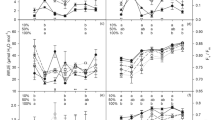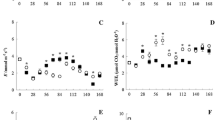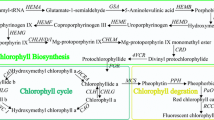Abstract
The ability of ornamental plants to acclimate to contrasting light environments via photoprotection mechanisms such as the violaxanthin (V) and lutein (Lx) cycles determines their success in managed landscapes. This study investigated whether provenance of origin influenced V and Lx cycle components in Acer grandidentatum L. (bigtooth maple) exposed to contrasting light environments. Seven-year-old bigtooth maple plants from two provenances, Lost Maples State Natural Area, Texas (LMPTX) and Guadalupe Mountains, Texas (GMTX) were subjected to unshaded conditions and 48 % shade. Regardless of light treatment, β-carotene content of plants from the LMPTX provenance (1,181 μg g−1) was higher than those from GMTX (964 μg g−1). Lutein content declined from day 5 to 10, but returned to day 5 levels at the end of the experiment at day 15. In contrast, more α-carotene accumulated at day 10 than at day 5. Although the conversion state of the xanthophyll pigment pool was unchanged, zeaxanthin was higher in unshaded than shaded bigtooth maple plants. Chlorophyll a and b decreased from day 5 to 10 and then increased on day 15. Light treatment did not cause photosystem II efficiency and relative water content to differ between the provenances, suggesting that they effectively acclimated to contrasting light conditions.





Similar content being viewed by others
Abbreviations
- A:
-
Antheraxanthin
- DMF:
-
N,N-dimethylformamide
- F v/F m :
-
Chlorophyll fluorescence
- LE:
-
Lutein-5,6-epoxide
- Lx :
-
Lutein epoxide
- V:
-
Violaxanthin
- VDE:
-
Violaxanthin de-epoxidase
- Z:
-
Zeaxanthin
- ZE:
-
Zeaxanthin epoxidase
References
Baroli I, Do AD, Yamane T, Niyogi KK (2003) Zeaxanthin accumulation in the absence of a functional xanthophyll cycle protects Chlamydomonas reinhardtii from photooxidative stress. Plant Cell 15:1–17
Bartosz G (1997) Oxidative stress in plants. Acta Physiol Plantarum 19:47–64
Beisel KG, Jahnke S, Hofmann D, Köppchen S, Schurr U, Matsubara S (2010) Continuous turnover of carotenes and chlorophyll a in mature leaves of Arabidopsis revealed by 14CO2 pulse-chase labeling. Plant Physiol 152:2188–2199
Bettmann GT, Ratnayaka HH, Molin WT, Sterling TM (2006) Physiological and antioxidant responses of cotton and spurred anoda (Anoda cristata) under nitrogen deficiency. Weed Sci 54:641–650
Boardman NK (1977) Comparative photosynthesis of sun and shade leaves. Annu Rev Plant Physiol 28:355–377
Bsoul E, St. Hilaire R, VanLeeuwen D (2006) Bigtooth maples exposed to asynchronous cyclic irrigation show provenance differences in drought adaptation mechanisms. J Am Soc Hortic Sci 131:459–468
Bsoul E, St. Hilaire R, VanLeeuwen D (2007) Bigtooth maples from selected provenances effectively endure deficit irrigation. HortScience 42:1167–1173
Chaves MM (1991) Effects of water deficits on carbon assimilation. J Exp Bot 42:1–16
Chen L, Cheng L (2003) Both xanthophyll cycle-dependent thermal dissipation and antioxidant system are up-regulated in grape (Vitis labrusca L. cv. Concord) leaves in response to N limitation. J Exp Bot 54:2165–2175
Cheng L (2003) Xanthophyll pool size and composition in relation to the nitrogen content of apple leaves. J Exp Bot 54:2165–2175
Close DC, Beadle CL (2003) The ecophysiology of foliar anthocyanin. Bot Rev 69:149–161
Demmig-Adams B, Adams WW III (1992) Photoprotection and other responses of plants to high light stress. Annu Rev Plant Physiol Mol Biol 43:599–626
Esteban R, Jiménez ET, Jiménez MS, Morales D, Hormaetxe K, Becerril JM, García-Plazaola JI (2007) Dynamics of violaxanthin and lutein epoxide xanthophyll cycles in Lauraceae tree species under field conditions. Tree Physiol 27:1407–1414
Feser CF, St. Hilaire R, VanLeeuwen D (2005) Development of in-ground container plants of Mexican elders exposed to drought. HortScience 40:446–450
Förster B, Osmond CB, Pogson BJ (2009) De novo synthesis and degradation of lx and v cycle pigments during shade and sun acclimation in avocado leaves. Plant Physiol 149:1179–1195
Förster B, Pogson BJ, Osmond CB (2011) Lutein from deepoxidation of lutein epoxide replaces zeaxanthin to sustain an enhanced capacity for nonphotochemical chlorophyll fluorescence quenching in avocado shade leaves in the dark. Plant Physiol 156:393–403
García-Plazaola JI, Hernández A, Olano JM, Becerril JM (2003) The operation of the lutein epoxide cycle correlates with energy dissipation. Funct Plant Biol 30:319–324
Gilman EF, Watson DG (1993) Acer grandidentatum: bigtooth maple. USDA Fact Sheet ST-16
Gratani L, Pesoli P, Cresente MF (1998) Relationship between photosynthetic activity and chlorophyll content in an isolated Quercus ilex L. tree during the year. Photosynthetica 35:445–451
Horton P, Ruban AV, Walters RG (1996) Regulation of light in green plants. Annu Rev Plant Physiol Plant Mol Biol 47:655–684
Johnson MP, Davison PA, Ruban AV, Horton P (2008) The xanthophyll cycle pool size controls the kinetics of non-photochemical quenching in Arabidopsis thaliana. FEBS Lett 582:262–266
Kivimäenpää M, Sutinen S, Calatayud V, Sanz MJ (2010) Visible and microscopic needle alterations of mature Aleppo pine (Pinus halepensis) trees growing on an ozone gradient in eastern Spain. Tree Physiol 30:541–554
Latowski D, Gryb J, Strzalka K (2004) The xanthophyll cycle: molecular mechanism and physiological significance. Acta Physiol Plant 26:197–212
Li Z, Ahn TK, Avenson TJ, Ballottari M, Cruz JA, Kramer DM, Bassi R, Fleming GR, Keasling JD, Niyogi KK (2009) Lutein accumulation in the absence of zeaxanthin restores nonphotochemical quenching in the Arabidopsis thaliana npq1 mutant. Plant Cell 21:1798–1812
Matsubara S, Krause GH, Aranda J, Virgo A, Beisel KG, Jahns P, Winter K (2009) Sun-shade patterns of leaf carotenoid composition in 86 species of neotropical forest plants. Funct Plant Biol 36:20–36
Moran R (1982) Formulae for determination of chlorophyllous pigments extracted with N,N-dimethylformamide. Plant Physiol 69:1376–1381
Niinemets Ü, Bilger W, Kull O, Tenhunen JD (1998) Acclimation to high irradiance in temperate deciduous trees in the field: changes in xanthophyll cycle pool size and in photosynthetic capacity along a canopy light gradient. Plant Cell Environ 21:1205–1218
Niyogi KK, Grossman AR, Björkman O (1998) Arabidopsis mutants define a central role for the xanthophyll cycle in the regulation of photosynthetic energy conversion. Plant Cell 10:1121–1134
Ort DR (2001) When there is too much light. Plant Physiol 125:29–32
Polívka T, Sundström V (2004) Ultrafast dynamics of carotenoid excited states-from solution to natural and artificial systems. Chem Rev 104:2021–2071
Verhoeven AS, Adams WM III, Demmig-Adams B, Croce R, Bassi R (1999) Xanthophyll cycle pigment localization and dynamics during exposure to low temperatures and light stress in Vinca major. Plant Physiol 120:727–773
Conflict of interest
The authors declare they have no conflict of interest.
Author information
Authors and Affiliations
Corresponding author
Additional information
Communicated by K. Trebacz.
Rights and permissions
About this article
Cite this article
Bowen-O’Connor, C.A., VanLeeuwen, D.M., Bettmann, G. et al. Variation in violaxanthin and lutein cycle components in two provenances of Acer grandidentatum L. exposed to contrasting light. Acta Physiol Plant 35, 541–548 (2013). https://doi.org/10.1007/s11738-012-1095-7
Received:
Revised:
Accepted:
Published:
Issue Date:
DOI: https://doi.org/10.1007/s11738-012-1095-7




